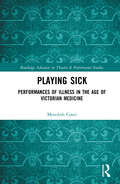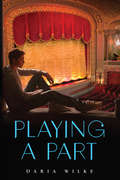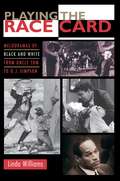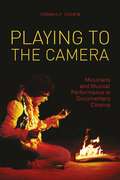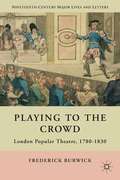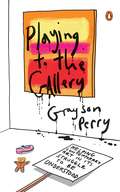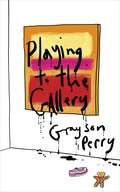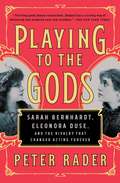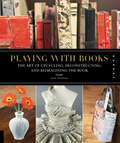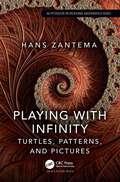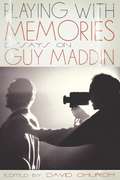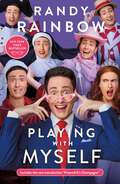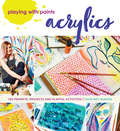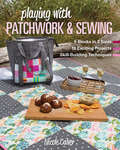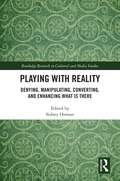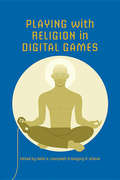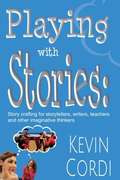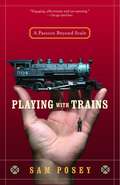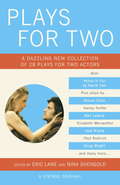- Table View
- List View
Playing Sick: Performances of Illness in the Age of Victorian Medicine (Routledge Advances in Theatre & Performance Studies)
by Meredith ContiFew life occurrences shaped individual and collective identities within Victorian-era society as critically as witnessing or suffering from illness. The prevalence of illness narratives within late nineteenth-century popular culture was made manifest on the period’s British and American stages, where theatrical embodiments of illness were indisputable staples of actors’ repertoires. Playing Sick: Performances of Illness in the Age of Victorian Medicine reconstructs how actors embodied three of the era’s most provocative illnesses: tuberculosis, drug addiction, and mental illness. In placing performances of illness within wider medicocultural contexts, Meredith Conti analyzes how such depictions confirmed or resisted salient constructions of diseases and the diseased. Conti’s case studies, which range from Eleonora Duse’s portrayal of the consumptive courtesan Marguerite Gautier to Henry Irving’s performance of senile dementia in King Lear, help to illuminate the interdependence of medical science and theatre in constructing nineteenth-century illness narratives. Through reconstructing these performances, Conti isolates from the period’s acting practices a lexicon of embodied illness: a flexible set of physical and vocal techniques that performers employed to theatricalize the sick body. In an age when medical science encouraged a gradual decentering of the patient from their own diagnosis and treatment, late nineteenth-century performances of illness symbolically restored the sick to positions of visibility and consequence.
Playing a Part
by Marian Schwartz Daria WilkeThe first young adult novel translated from Russian, a brave coming-out, coming-of-age story.In June 2013, the Russian government passed laws prohibiting "gay propaganda," threatening jail time and fines to offenders. That same month, in spite of these harsh laws, a Russian publisher released PLAYING A PART, a young adult novel with openly gay characters. It was a brave, bold act, and now this groundbreaking story has been translated for American readers.In PLAYING A PART, Grisha adores everything about the Moscow puppet theater where his parents work, and spends as much time there as he can. But life outside the theater is not so wonderful. The boys in Grisha's class bully him mercilessly, and his own grandfather says hateful things about how he's not "masculine" enough. Life goes from bad to worse when Grisha learns that Sam, his favorite actor and mentor, is moving: He's leaving the country to escape the extreme homophobia he faces in Russia. How Grisha overcomes these trials and writes himself a new role in his own story is heartfelt, courageous, and hopeful.
Playing a Part in History
by Margaret RogersonThe York Mystery Plays are a cycle of originally performed on wagons in the city. They date from the fourteenth century and Biblical narrative from Creation to Last Judgment. After nearly four hundred years without a performance, a revival of the York Mysteries began in 1951 when local amateurs led by professional theatre practitioners staged them during the festival of Britain. Playing a Part in History examines the ways in which the revival of these plays transformed them for twentieth- and twenty-first-century audiences. Considering such topics as the contemporary popularity of the plays, the agendas of the revivalists, and major production differences, Margaret Rogerson provides a fascinating comparison of medieval and modern English drama. Drawing extensively on archival material, and newspaper and academic reviews of the plays in recent years, Playing a Part in History is not only an illuminating account of early English drama, but also of the ways in which theatre allows people to interact with the past.
Playing the Race Card: Melodramas of Black and White from Uncle Tom to O. J. Simpson
by Linda WilliamsThe black man suffering at the hands of whites, the white woman sexually threatened by the black man. Both images have long been burned into the American conscience through popular entertainment, and today they exert a powerful and disturbing influence on Americans' understanding of race. So argues Linda Williams in this boldly inquisitive book, where she probes the bitterly divisive racial sentiments aroused by such recent events as O. J. Simpson's criminal trial. Williams, the author of Hard Core, explores how these images took root, beginning with melodramatic theater, where suffering characters acquire virtue through victimization. The racial sympathies and hostilities that surfaced during the trial of the police in the beating of Rodney King and in the O. J. Simpson murder trial are grounded in the melodramatic forms of Uncle Tom's Cabin and The Birth of a Nation. Williams finds that Stowe's beaten black man and Griffith's endangered white woman appear repeatedly throughout popular entertainment, promoting interracial understanding at one moment, interracial hate at another. The black and white racial melodrama has galvanized emotions and fueled the importance of new media forms, such as serious, "integrated" musicals of stage and film, including The Jazz Singer and Show Boat. It also helped create a major event out of the movie Gone With the Wind, while enabling television to assume new moral purpose with the broadcast of Roots. Williams demonstrates how such developments converged to make the televised race trial a form of national entertainment. When prosecutor Christopher Darden accused Simpson's defense team of "playing the race card," which ultimately trumped his own team's gender card, he feared that the jury's sympathy for a targeted black man would be at the expense of the abused white wife. The jury's verdict, Williams concludes, was determined not so much by facts as by the cultural forces of racial melodrama long in the making. Revealing melodrama to be a key element in American culture, Williams argues that the race images it has promoted are deeply ingrained in our minds and that there can be no honest discussion about race until Americans recognize this predicament.
Playing to the Camera: Musicians and Musical Performance in Documentary Cinema (Nonfictions)
by Thomas CohenPlaying to the Camera is the first full-length study devoted to the musical performance documentary. Its scope ranges from rock concert films to experimental video art featuring modernist music. Unlike the 'music under' produced for films by unseen musicians, on-screen 'live' performances show us the bodies that produce the sounds we hear. Exploring the link between moving images and musical movement as physical gesture, this volume asks why performance is so often derided as mere skill whereas composition is afforded the status of art, a question that opens onto a broader critique of attitudes regarding mental and physical labor in Western culture.
Playing to the Crowd
by Frederick BurwickThe firststudy ofthe productions of the minor theatres, how theywere adapted toappealto the local patrons and the audienceswho worked and lived inthese communities. "
Playing to the Gallery
by Grayson PerryGrayson Perry's book will overturn everything you thought you knew about "art"Now Grayson Perry is a fully paid-up member of the art establishment, he wants to show that any of us can appreciate art (after all, there is a reason he's called this book Playing to the Gallery and not Sucking Up to the Academic Elite). This funny, personal journey through the art world answers the basic questions that might occur to us in an art gallery but that we're too embarrassed to ask. Questions such as: What is "good" or "bad" art--and does it even matter? Is art still capable of shocking us or have we seen it all before? And what happens if you place apiece of art in a rubbish dump?
Playing to the Gallery: Helping Contemporary Art in its Struggle to Be Understood
by Grayson Perry'I have never read such a stimulating short guide to art' Lynn Barber, Sunday Times Now Grayson Perry is a fully paid-up member of the art establishment, he wants to show that any of us can appreciate art (after all, there is a reason he's called this book Playing to the Gallery and not 'Sucking up to an Academic Elite'). Based on his hugely popular BBC Radio 4 Reith Lectures and full of pictures, this funny, personal journey through the art world answers the basic questions that might occur to us in an art gallery but seem too embarrassing to ask.
Playing to the Gods: Sarah Bernhardt, Eleonora Duse, and the Rivalry that Changed Acting Forever
by Peter RaderThe riveting story of the rivalry between the two most renowned actresses of the nineteenth century: legendary Sarah Bernhardt, whose eccentricity on and off the stage made her the original diva, and mystical Eleonora Duse, who broke all the rules to popularize the natural style of acting we celebrate today.Audiences across Europe and the Americas clamored to see the divine Sarah Bernhardt swoon—and she gave them their money’s worth. The world’s first superstar, she traveled with a chimpanzee named Darwin and a pet alligator that drank champagne, shamelessly supplementing her income by endorsing everything from aperitifs to beef bouillon, and spreading rumors that she slept in a coffin to better understand the macabre heroines she played. Eleonora Duse shied away from the spotlight. Born to a penniless family of itinerant troubadours, she disappeared into the characters she portrayed—channeling their spirits, she claimed. Her new, empathetic style of acting revolutionized the theater—and earned her the ire of Sarah Bernhardt in what would become the most tumultuous theatrical showdown of the nineteenth century. Bernhardt and Duse seduced each other’s lovers, stole one another’s favorite playwrights, and took to the world’s stages to outperform their rival in her most iconic roles. A scandalous, enormously entertaining history full of high drama and low blows, Playing to the Gods is the page-turning account of the feud that changed theater forever.
Playing with Books: The Art of Upcycling, Deconstructing, and Reimagining the Book
by Jason ThompsonA guide to repurposing used books and pages into unique, accessible art projects—the perfect gift for artists, crafters and book lovers.In these pages, Jason Thompson has curated an extensive and artistic range of both achievable upcycled crafts made from books and book pages and an amazing gallery that contains thought-provoking and beautiful works that transform books into art.The content encompasses a wide range of techniques and step-by-step projects that deconstruct and rebuild books and their parts into unique, recycled objects. The book combines in equal measure bookbinding, woodworking, paper crafting, origami, and textile and decorative arts techniques, along with a healthy dose of experimentation and fun. The beautiful high-end presentation and stunning photography make this book a delightful, must-have volume for any book-loving artist or art-loving book collector.
Playing with Infinity: Turtles, Patterns, and Pictures (AK Peters/CRC Recreational Mathematics Series)
by Hans ZantemaThis is a book about infinity - specifically the infinity of numbers and sequences. Amazing properties arise, for instance, some kinds of infinity are argued to be greater than others. Along the way the author will demonstrate how infinity can be made to create beautiful ‘art’, guided by the development of underlying mathematics. This book will provide a fascinating read for anyone interested in number theory, infinity, math art, and/or generative art, and could be used a valuable supplement to any course on these topics.Features: Beautiful examples of generative art Accessible to anyone with a reasonable high school level of mathematics Full of challenges and puzzles to engage readers
Playing with Memories: Essays on Guy Maddin
by David ChurchPlaying with Memories is the first collection of scholarly essays on the work of internationally acclaimed Canadian filmmaker Guy Maddin. It offers extensive perspectives on his career to date, from the early experimentation of The Dead Father (1986) to the intensely intimate revelations of My Winnipeg (2007). Featuring new and updated essays from American, Canadian, and Australian scholars, collaborators, and critics, as well as an in-depth interview with Maddin, this collection explores the aesthetics and politics behind Maddin’s work, firmly situating his films within ongoing cultural debates about postmodernism, genre, and national identity.
Playing with Myself
by Randy RainbowAn intimate and light-hearted memoir by viral sensation and three-time Emmy-nominated musical comedian Randy Rainbow that takes readers through his life—the highs, the lows, the lipstick, the pink glasses, and the show tunes.Randy Rainbow, the man who conquered the Internet with a stylish pair of pink glasses, an inexhaustible knowledge of Broadway musicals, and the most gimlet-eyed view of American politics this side of Mark Twain finally tells all in Playing with Myself, a memoir sure to cause more than a few readers to begin singing one of his greatest hits like “A Spoonful of Clorox” or “Cover Your Freakin’ Face.” As Randy has said, “There’s so much fake news out there about me. I can’t wait to set the record straight and finally give people a peek behind the green screen.” And set the record straight he does. Playing with Myself is a first-hand account of the journey that led Randy Rainbow from his childhood as the over-imaginative, often misunderstood little boy who carried a purse in the second grade to his first job on Broadway as the host at Hooters and on to the creation of his trademark comedy character. In chapters titled “Pajama Bottoms” (a look back at the days when he wore pajama bottoms on his head to pretend he was Dorothy in The Wizard of Oz), “Yes, It’s My Real Name, Shut Up!” (no explanation necessary...) and “Pink Glasses” (a rose-colored homage to his favorite accessory), Playing with Myself is a memoir that answers the question “Can an introverted musical theatre nerd with a MacBook and a dream save the world, one show tune at a time?”
Playing with Paints - Acrylics: 100 Prompts, Projects And Playful Activities
by Courtney BurdenBreak the rules and explore acrylic paint in a free and fun way. This book encourages you to get over the fear of the blank canvas and the anxiety over the outcome so you can focus on the process of painting and the pure joy of creating. Whether you're a novice who doesn't know how to get started or a classical painter looking to try something new, you will benefit from the activities in this book, which range from quick, messy and expressive exercises to relaxing and meditative paintings. Courtney Pilgrim shares 100 prompts, projects and playful activities that will build your confidence, inspiring you to roll up your sleeves and play with acrylic paint in a pressure-free way. There is no right or wrong way to create a painting, so enjoy the journey, relax, unwind and have fun!
Playing with Paints - Watercolor: 100 Prompts, Projects And Playful Activities
by Sara FundukGet creative expressing yourself with watercolor paint by focusing on having fun and getting to know this versatile medium. More than 100 lessons help those who have never picked up a paintbrush before enjoy the pleasure of watercolor. In each chapter, you will progress through quick, simple exercises designed to get you started, then practice pages build on techniques. This book also shows those with more experience how to be inspired in new ways. Includes information on choosing supplies, mixing colors, making those first few brushstrokes, and quick, simple projects that range from making a joyful mess to beautiful pieces you can be proud of.
Playing with Patchwork & Sewing: 6 Blocks in 3 sizes, 18 Exciting Projects, Skill-building Techniques
by Nicole CalverPiece modern home decor and gifts with these 18 projects that can help build your skills.Are you a sewist who wants to break into quilting? Or a quilter who’d like to turn your blocks into something a little more dimensional? Take a walk on the wild side with eighteen projects that combine the best of both worlds! Create useful gifts and home decor, including bright modern quilts, a pencil case, notebook cover, market bag, and more. Plus, explore new skills with each project! Nicole shares simple instructions for basic patchwork, foundation piecing, English paper piecing, and an easy way to machine appliqué. Each block comes in three sizes, so you can practice new techniques with larger fabric cuts before moving on to smaller pieces.Stitch six blocks in mega, medium, and micro projects! Perfect for beginning quilters and more advanced sewistsLearn a new technique with a large-scale project, then try out the same block with smaller piecesSew modern quilts, striking pillows, table toppers, pincushions, and more useful handmade gifts
Playing with Reality: Denying, Manipulating, Converting, and Enhancing What Is There (Routledge Research in Cultural and Media Studies)
by Sidney HomanThis volume explores how and why we deny, or manipulate, or convert, or enhance reality. Finding it important to come to terms with reality, with what is there before us, and, with reality however defined, to live responsibly, this collection takes a truly multidisciplinary approach to examining the idea that history, the truth, facts, and the events of the present time can be refashioned as prismatic, theatrical, something we can play with for agendas either noble or ignoble. An international team of contributors considers the issue of how and why, in dealing what is there before us, we play with reality by employing theatre, fiction, words, conspiracy theories, alternate realities, scenarios, and art itself. Chapters delve into issues of fake news, propaganda, virtual reality, theatre as real life, reality TV, and positive ways of refashioning and enhancing your own reality. Drawing on examples from film studies to sociology, from the social sciences to medicine, this volume will appeal to scholars and upper-level students in the areas of communication and media studies, comparative literature, film studies, economics, English, international affairs, journalism, philosophy, psychology, sociology, and theatre.
Playing with Religion in Digital Games
by Heidi A. Campbell Gregory P. GrieveShaman, paragon, God-mode: modern video games are heavily coded with religious undertones. From the Shinto-inspired Japanese video game Okami to the internationally popular The Legend of Zelda and Halo, many video games rely on religious themes and symbols to drive the narrative and frame the storyline. Playing with Religion in Digital Games explores the increasingly complex relationship between gaming and global religious practices. For example, how does religion help organize the communities in MMORPGs such as World of Warcraft? What role has censorship played in localizing games like Actraiser in the western world? How do evangelical Christians react to violence, gore, and sexuality in some of the most popular games such as Mass Effect or Grand Theft Auto? With contributions by scholars and gamers from all over the world, this collection offers a unique perspective to the intersections of religion and the virtual world.
Playing with Stories: Story-crafting for storytellers, writers, teachers and other imaginative thinkers
by Kevin D. CordiAn educator's manual for teachers, leaders and students of oral storytelling arts developed by a Ph.D. professor who has worked extensively with all ages.
Playing with Trains: A Passion Beyond Scale
by Sam PoseyWhy do grown men play with trains? Is it a primal attachment to childhood, nostalgia for the lost age of rail travel, or the stuff of flat-out obsession? In this delightful and unprecedented book, Grand Prix legend Sam Posey tracks those who share his “passion beyond scale” and discovers a wonderfully strange and vital culture. Posey’s first layout, wired by his mother in the years just after the Second World War, was, as he writes in his Introduction, “a miniature universe which I could operate on my own. Speed and control: I was fascinated by both, as well as by the way they were inextricably bound together. ” Eventually, when Posey’s son was born, he was convinced that building him a basement layout would be the highest expression of fatherhood. Sixteen years and thousands of hours later, this project, “the outgrowth of chance meetings, unexpected friendships, mistakes, illness, latent ambitions, and sheer luck” was completed. But for Posey, the creation of his HO-scale masterpiece based on the historic Colorado Midland, was just the beginning. In Playing with Trains, Sam Posey ventures well beyond the borders of his layout in northwestern Connecticut, to find out what makes the top modelers tick. He expects to find men “engaged in a genial hobby, happy to spend a few hours a week escaping the pressures of contemporary life. ” Instead he uncovers a world of extremes–extreme commitment, extreme passion, and extreme differences of approach. For instance, Malcolm Furlow, holed up on his ranch in the wilderness of New Mexico, insists that model railroading is defined by scenery and artistic self-expression. On the other hand, Tony Koester, a New Jersey modeler, believes his “mission” is to replicate, with fanatical precision and authenticity, the way a real railroad operates. Going to extremes himself, Posey actually “test drives” a real steam engine in Strasburg, Pennsylvania, in an attempt to understand the great machines that inspired the models and connect us to a time when “the railroad was inventing America. ” Timeless and original, Playing with Trains reveals a classic, questing American world.
Playland
by Kathryn W. Burke Andrew J. SpanoPlayland offers an inviting look at the historic amusement park on the shore of the Long Island Sound in Rye. This book recalls the early days and the later years of Playland, a national historic landmarkand America's only publicly owned amusement park. Opened in 1928 as part of the newly developed Westchester County Park System, Playland originally drew crowds that arrived via automobile, bus, and steamship for the circus acts, sideshows, and rides, such as the Swooper, an oval roller coaster, and the Derby Racer, one of only two left in the UnitedStates. An all-purpose resort, the park included a beach, bathhouse, pool, and casino with restaurants and games. Today the park draws even larger crowds--nearly a million people each season--that come for theDragon Coaster and other rides, Kiddyland, the indoor ice rink, the pool, the beach, and the boardwalk.
Plays and their Makers up to 1576
by Glynne WickhamThis volume forms part of the 5 volume set Early English Stages 1300-1660. This set examines the history of the development of dramatic spectacle and stage convention in England from the beginning of the fourteenth century to 1660.
Plays for Three
by Eric Lane Nina ShengoldPLAYS FOR THREE is a unique anthology of 23 outstanding plays for three actors by an exciting mix of established and emerging playwrights. Everyone's heard that "Two's company, three's a crowd." That may be true on a date, but on stage, three is a magic number. Add a third character to any interaction and the dramatic possibilities increase exponentially: suddenly there's competition, intrigue, shifting allegiances, comic misunderstandings, secrets and lies. Triangles make excellent drama, and three-handers offer the kind of substantial and challenging roles that actors love. Plays for Three offers six full-length and seventeen short plays featuring dramatic trios of every sort. Rob AckermanPete BarryStephen BelberCesi DavidsonAdrienne DawesPhilip DawkinsCatherine FillouxMadeleine GeorgeAmlin GrayFrank HigginsCory HinkleWendy KesselmanEric LaneKitt LavoieMark Harvey LevineMatthew LopezDonald MarguliesAnna MoenchA. Rey PamatmatDavid Riedy Nina ShengoldStephen WebbCraig WrightFrom the Trade Paperback edition.
Plays for Two
by Eric Lane Nina ShengoldPlays for Two is a unique anthology of twenty-eight terrific plays for two actors, by a mix of celebrated playwrights and cutting-edge new voices.It takes two to tango--or to perform a duet, fight a duel, or play ping-pong. The two-character play is dramatic confrontation stripped to its essence. These four full-length and twenty-four short plays feature pairs of every sort--strangers, rivals, parents and children, siblings, co-workers, friends, and lovers--swooning or sparring, meeting cute or parting ways. In a dizzying range of moods and styles, these two-handers offer the kind of meaty, challenging roles actors love, while providing readers and audiences with the pleasures of watching the complex give-and-take dynamics of two keenly matched characters.Plays by: Billy Aronson, David Auburn, Pete Barry, Naveen Bahar Choudhury, Anthony Clarvoe, Steven Dietz, Halley Feiffer, Simon Fill, Frank Higgins, David Ives, Jacob Juntunen, Ean Miles Kessler, Neil LaBute, Eric Lane, Kitt Lavoie, Jacqueline E. Lawton, Mark Harvey Levine, Elizabeth Meriwether, Michael Mitnick, Daria Polatin, Marco Ramirez, Kelly Rhodes, Jose Rivera, Paul Rudnick, Edwin Sanchez, Nina Shengold, Cori Thomas, Doug Wright From the Trade Paperback edition.
